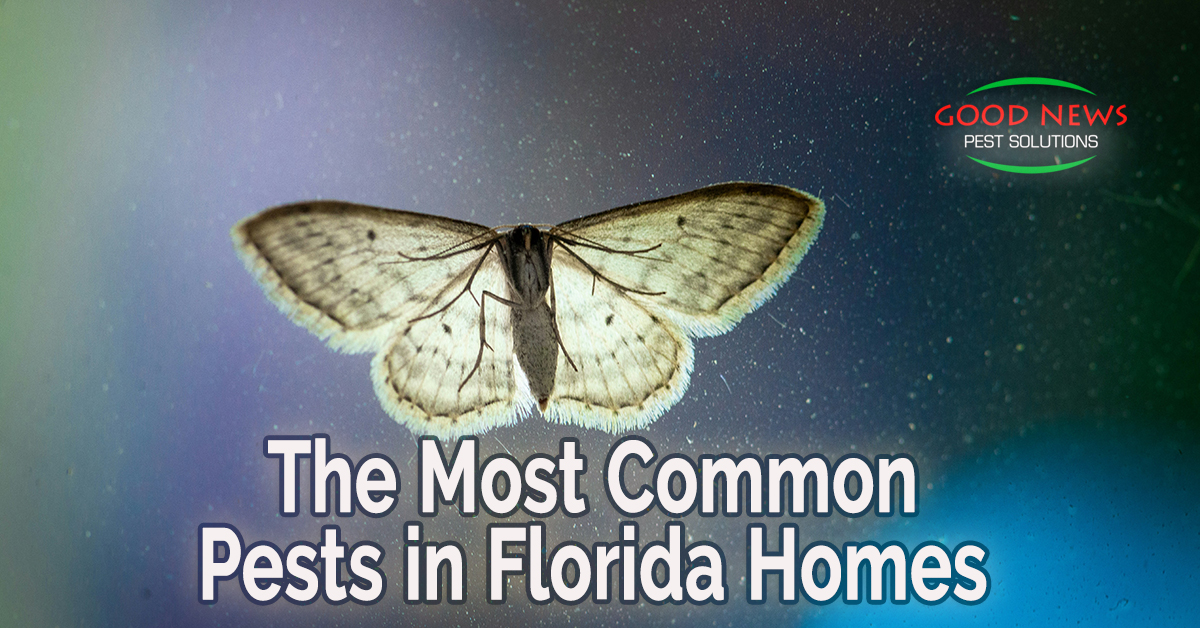
The Most Common Pests in Florida Homes - Part 3
As we leave Valentine’s Day and Fat Tuesday in the rear-view mirror, we enter the season of Lent – a time of sacrifice in preparation for Easter Sunday. Continuing our series on the most common pests we find in Florida homes, today we’ll look at two insects that won’t trouble your body but may damage the things you own.
Like Moths Not to a Flame?
You probably recognize some variation of the above phrase, but earlier this year researchers concluded that, in fact, moths aren’t drawn to our artificial lights, just seriously confused by them. They actually spin around trying to keep their backs to the light.
Moths are thicker and fuzzier than their Lepidoptera cousins, the butterfly. While the average size of a moth is around one inch wingtip to wingtip, there are giant moths that are nearly a foot across and pygmy moths smaller than a quarter of an inch.
Moths are nocturnal, do some pollinating, and provide a food source for bats, birds and some small mammals. One of the ways they protect themselves from being eaten is to pretend to be other plants or animals – like an owl or a hornet. They don’t have noses – or their bodies are one giant nose, depending on your perspective.
While we sometimes think of moths as being a nuisance, it’s the pre-teen caterpillars that are really the problem. While some, like the silkworm caterpillars, provide a valuable resource (there are even silkworm farms) others live to destroy.
Spongy moth caterpillars are an invasive species that cause damage to forests in the Northeast. Codling moth caterpillars feed primarily on the leaves of various fruit trees. The African sugarcane borer eats its weight in maize, sorghum, cassava, rice, and of course, sugarcane. Closer to home, the diamondback moths endanger the lives of cabbage, mustard, and kale plants.
The moths around your outside lights aren’t the ones who usually make it into your home – although it happens from time to time. The ones you need to worry about are clothing moths – and unfortunately, you don’t usually spot them until after the damage is done. Like the other destructive moths, it’s the caterpillar of the family Tineidae that eats fabrics – sweaters, blankets, and other clothes made of wool or silk.
Scales, But Not Fish
If you haven’t encountered silverfish yet, you’re likely to do so soon. Lepisma saccharina have been on the earth since the dinosaurs. And thanks to the high level of humidity on the Gulf Coast of Florida, silverfish are almost as ubiquitous as mosquitoes. They just hide better.
Named for the fine, silvery scales that cover their bodies, silverfish grow and prosper in damp, dark, and cool places. They require lots of humidity but shy away from direct sunlight. Often newly constructed buildings will harbor large populations of the insect that spread out when humans move in.
While they won’t bite or sting you, silverfish have been known to trigger some folks’ allergies. They’ll also leave things behind in your food. It’ll make you think you’re sick even if you can’t tell the difference.
Silverfish will eat just about anything, including pantry staples, fabric, glue, meat and other dead insects. But their favorite meal is cellulose – in the form of cardboard and pages of books and magazines.
Given enough time and access, silverfish can literally eat you out of house and home. Diatomaceous earth, borax, and cedar oil can help cut down on silverfish. However, adult silverfish lay eggs constantly and can survive for up to 6 months without food, so they can be hard for the average homeowner to control.
Thankfully, the silverfish is one of the persistent pests we eliminate and prevent in our Go Green Perimeter Plus program. This solution starts with identifying all entry points of your house, then utilizes the most environmentally beneficial and safest for your family treatments we can find. We get rid of roaches, spiders, ants and silverfish – and keep them out. For more details, please give us a call!
« Back to Blog
Proudly Serving
Sun City Center, Ruskin, Palmetto, Parrish, Ellenton, Bradenton, Anna Maria, Holmes Beach, Bradenton Beach, Longboat Key, Lakewood Ranch, University Park, Myakka City, Sarasota, Siesta Key, Osprey, Nokomis, Casey Key, Venice, Englewood, North Port, Port Charlotte, Punta Gorda, Arcadia
Things You Can Do
Pay Your Bill Online
Leave Us a Review
Request a Free* Termite Inspection
Stop Mosquito Bites
Get Rid of Rodents
Get a Termite Damage Warranty
Get Pest Control for Your Attic
Get Pest Control for Your Business Request Prayer
Corporate Address
1080 Enterprise Court, Ste A
North Venice, FL 34275
Call Now: (941) 412-9610
Text: (941) 412-9610
Fax: (941) 412-0080
